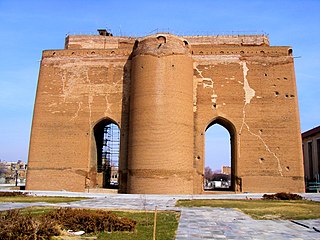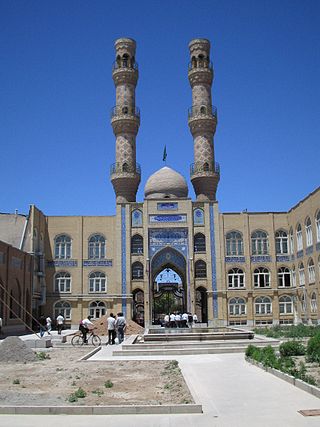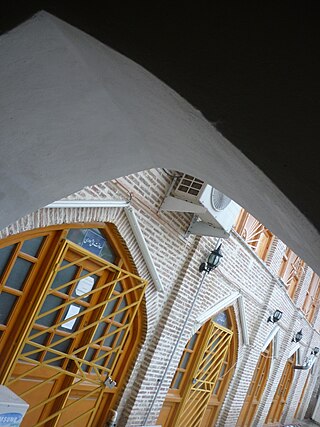
Qazvin province is one of the 31 provinces of Iran. It is in the northwest of the country, with the city of Qazvin as its capital.

Arg of Tabriz, is the remnants of a large acropolis fortification and city wall in downtown Tabriz, Iran. Its structure is visible from far distances in downtown Tabriz, if not blocked by the newly erected highrise buildings.

An Iranian architect is traditionally called a mi'mar.

The Blue Mosque is a historic mosque in Tabriz, Iran. The construction of the Blue Mosque, also known as Masjed-e Moẓaffariya, started during the rule of the Qarā Qoyunlu dynasty (1351–1469) and was completed in 1465 during the reign of the Āq Qoyunlu The famous Blue Mosque is widely recognized as the last remaining example of Turkmen architectural and decorative styles in the city. The features of Blue Mosque prompted the scholars to explore the innovative features of Tabriz's ceramic tile craftsmanship—highlighting its distinctive "blue-and-white" patterns, lusterware, and gilded cobalt tiles, which for a considerable time were recognized as the sole known example of their kind.

The Sāheb ol Amr Mosque or King Tahmasp Mosque is a mosque located on the east side of Saaheb Aabaad square in Tabriz, Iran. The mosque was initially built in 1636 and has a history of destruction and repair. The name Sāheb ol Amr is one of the titles of the last Twelver Shī‘ah Imām.

Rowangchhari is an upazila (sub-district) of Bandarban District in southeastern Bangladesh, part of the Chittagong Division.

The Jāmeh Mosque of Yazd is the grand, congregational mosque (Jāmeh) of Yazd city, within the Yazd province of Iran. The mosque is depicted on the obverse of the Iranian 200 rials banknote.
Dakshin Shahbazpur or South Shahbazpur is a Union Parishad under Barlekha Upazila of Moulvibazar District in the division of Sylhet, Bangladesh. It has an area of 40.46 square miles and a population of 26,840.

The Jāmeh Mosque is a large, congregational mosque (Jāmeh) in Tabrīz city, within the East Azerbaijan Province of Iran. It is located in the Bazaar suburb of Tabriz next to the Grand Bazaar of Tabriz and the Constitution House of Tabriz.

The Jāmeh Mosque of Amol is the grand, congregational mosque (Jāmeh) of Amol, Mazandaran Province, Iran. Mosque location in Amol Sassanid Bazaar. Its primary structure dates to the first century AH and during the reign of the Qajar dynasty and Safavid dynasty renovation.

The Jāme Mosque of Urmia, also known as the Rezayieh Mosque, is the grand, congregational mosque (Jāme) of Urmia, Iran. The mosque is situated in the older part of the city and was constructed in 13th century during the Ilkhanate era.

Asrafia Jame Masjid, previously known as the Mosque of Ahladi Bibi, is a mosque located in the urban neighbourhood of Amlapara, in the city of Narayanganj, Bangladesh. It was built during the British Raj colonial period, dating back to the 1890s.

Jameh Mosque of Ardakan dates back to the Safavid dynasty and is located in Ardakan, next to the public library.

Jameh Mosque of Sari is related to the Qajar dynasty and is located in Sari, the district of Chinarban. The Jameh Mosque of Sari is located in Nargesiye daily market in Chenarbon district in Sari, the capital city of Mazandaran Province, in North of Iran. It dates back to pre-Islam era and used to be a fire-temple of Zoroastrians of Iran in the North, next to the Caspian Sea. After the acceptance of Islam by the people in the region, a mosque, known as Jameh Mosque, was constructed on the site of the temple. It is the first mosque built in the North of Iran.

The Jameh Mosque of Babol is related to the Qajar dynasty and is located in Babol, near the cultural Intersection.

Jameh Mosque of Tehran is the oldest mosque in Tehran, with its oldest Shabestan, more than a thousand years old, and is also known as the Atiq Mosque.

The Jameh Mosque of Kermanshah, also called the Chehel Sotoun mosque, is located in the old City of Kermanshah, on Modarres Street, to Rashid Yasemi Street.

Jameh Mosque of Qom is one of the oldest mosques in Qom. Qom's mosque is located in downtown Qom.

Jome mosque is related to the Seljuq dynasty and is located in Ardabil Province, Ardabil.

Asgar Ali Chowdhury Jame Mosque is a mosque located at Chowdhury Para Road, Halisahar. The mosque was founded by Asgar Ali Chowdhury, who was from the elite Chowdhury family of Halishahar.


















